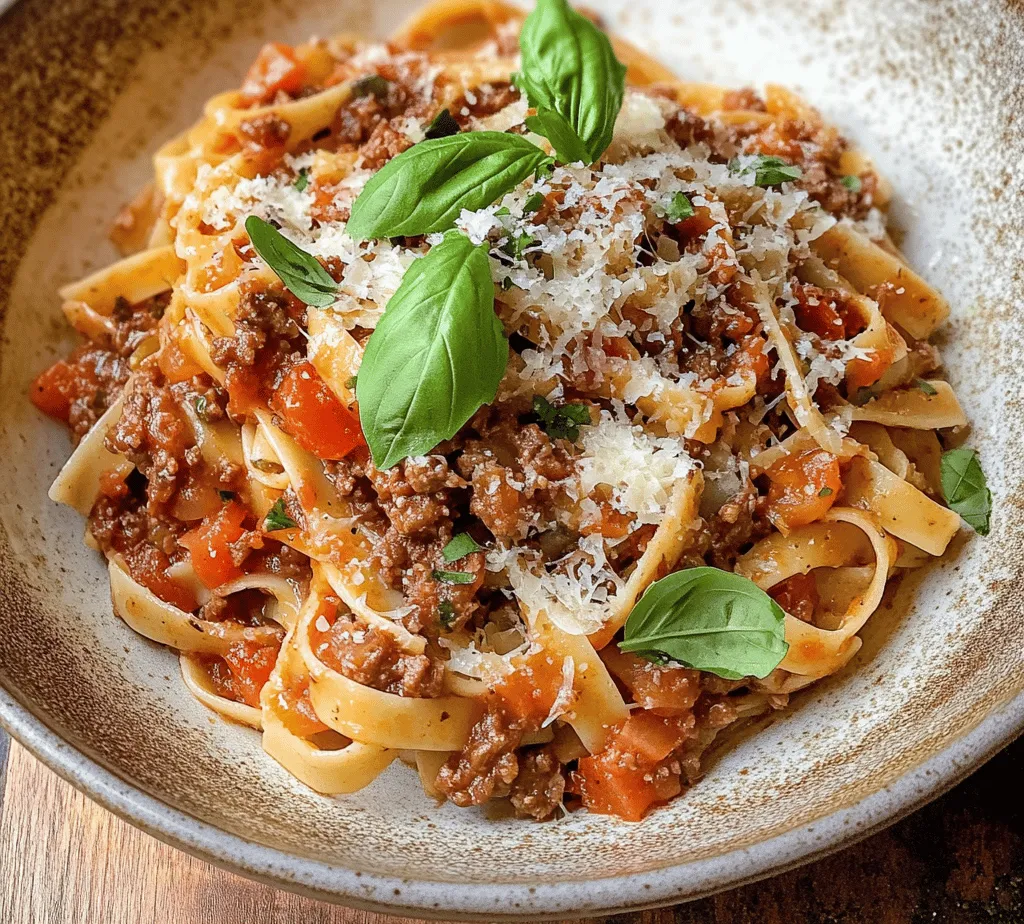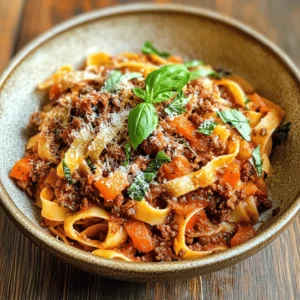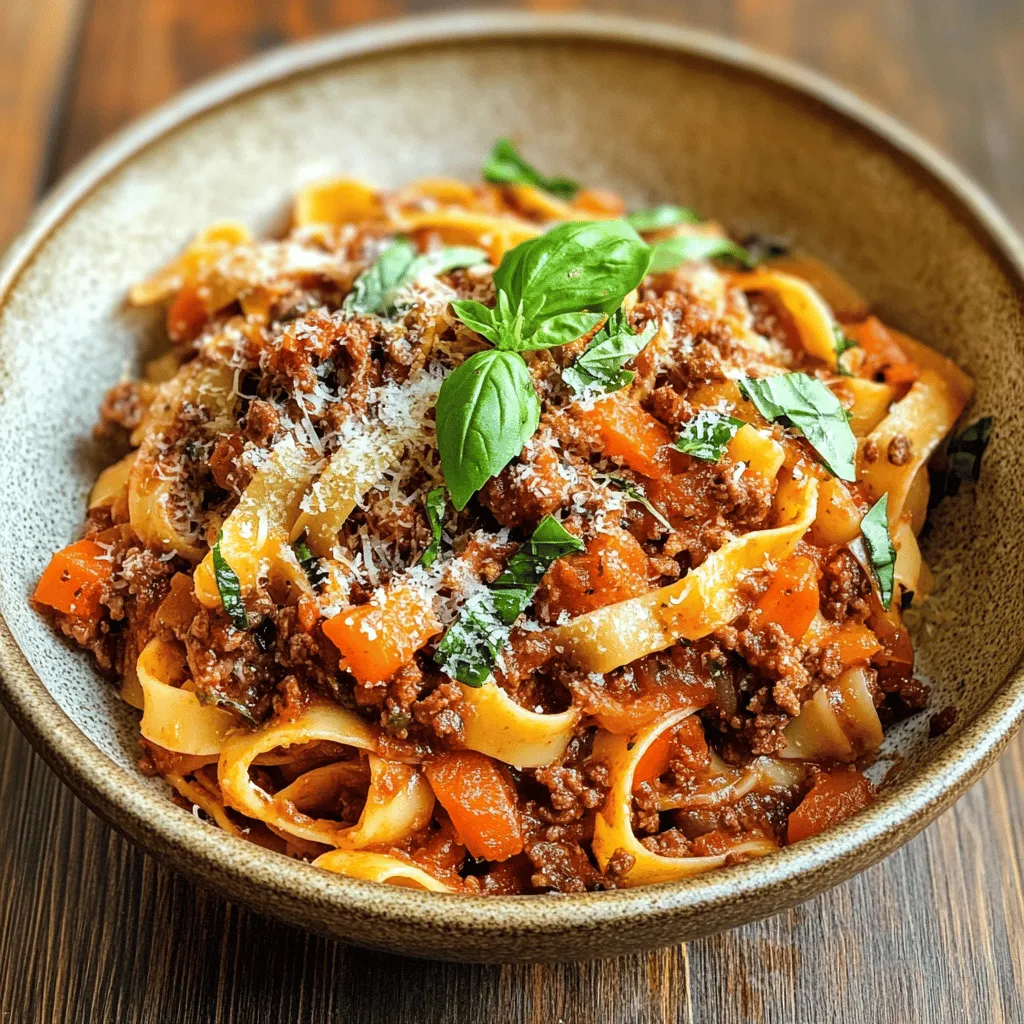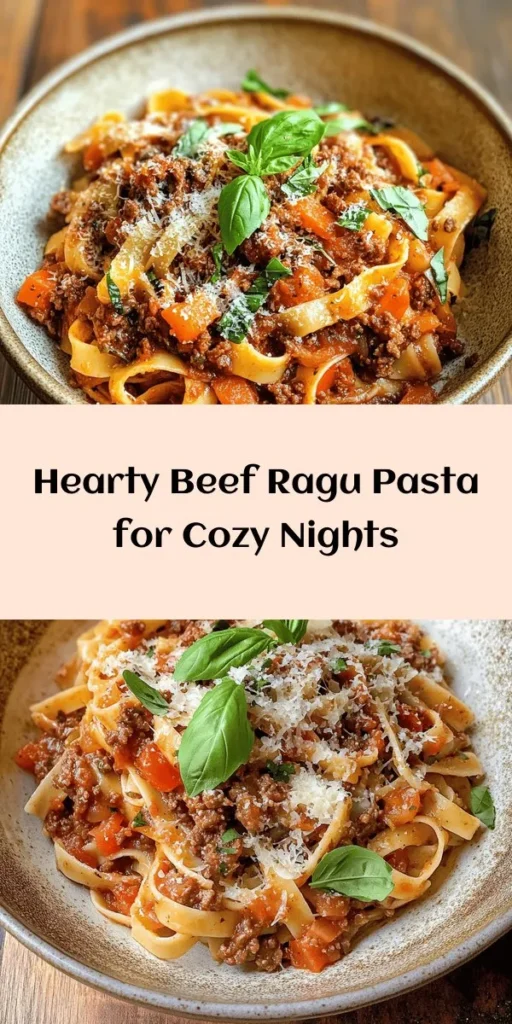Introduction
Savory Beef Ragu Pasta is a dish that embodies the essence of comfort food, a staple in many culinary cultures around the world. With its rich, meaty sauce served over pasta, this dish offers a satisfying blend of flavors and textures that warms the heart and soul. Originating from Italian cuisine, ragu has evolved through the centuries, with numerous regional variations showcasing local ingredients and traditions. This particular version, featuring ground beef simmered with aromatic vegetables and herbs, has become a beloved favorite among families and food enthusiasts alike.
Comfort food plays a vital role in our culinary culture, often evoking fond memories of family gatherings, cozy dinners, and special celebrations. Savory Beef Ragu Pasta is versatile enough to be the star of a casual weeknight dinner or a centerpiece at festive occasions. Whether you are hosting a dinner party or simply craving a hearty meal after a long day, this dish satisfies both the palate and the spirit, making it a go-to choice for many home cooks.
In this article, we will explore the key components of Savory Beef Ragu Pasta, from the essential ingredients to cooking techniques that ensure a delicious end result. By understanding the nuances of this dish, you can create a meal that not only delights the taste buds but also nourishes the body with wholesome ingredients.
Understanding the Ingredients
The foundation of any great dish lies in its ingredients, and Savory Beef Ragu Pasta is no exception. The key components of this recipe include ground beef, a medley of vegetables, canned tomatoes, herbs, and, of course, pasta. Each ingredient plays a crucial role in building flavor and nutrition, making it essential to choose high-quality components.
Ground Beef
Ground beef serves as the star of the ragu sauce. It provides a rich, meaty flavor that forms the backbone of the dish. When selecting ground beef, look for a blend with a moderate fat content (around 80/20) to maintain juiciness and flavor during cooking. Leaner cuts can dry out, while fattier varieties may overpower the other flavors. Ground beef is not only delicious but also a good source of protein, iron, and essential vitamins, making it a nutritious choice for hearty meals.
Vegetables
The vegetable base of the ragu typically consists of onions, garlic, carrots, and celery. This combination, known as soffritto, is a traditional Italian technique that creates a savory flavor foundation. Onions add sweetness and depth, garlic provides aromatic notes, carrots contribute natural sweetness and color, and celery adds a subtle earthiness. Together, these vegetables not only enhance the flavor profile of the ragu but also boost its nutritional value with vitamins and minerals.
Canned Tomatoes and Tomato Paste
Tomatoes are essential in creating the rich sauce that coats the pasta. Canned tomatoes, whether whole, diced, or crushed, provide a concentrated flavor that intensifies as the sauce simmers. Tomato paste, on the other hand, adds depth and richness, thickening the sauce and enhancing the overall taste. Together, they create a vibrant red sauce that pairs beautifully with the beef and pasta.
Herbs and Spices
Fresh or dried herbs, such as basil, oregano, and thyme, are commonly used to season the ragu. These herbs add complexity and aromatic qualities to the sauce, elevating it from simple to extraordinary. Additionally, a pinch of salt and pepper is crucial for balancing flavors and enhancing the overall dish.
Cooking Pasta to Perfection
Choosing the right pasta is an integral part of creating a successful Savory Beef Ragu Pasta. While traditional options like fettuccine or pappardelle work wonderfully, other pasta shapes such as tagliatelle or even penne can be used to suit your preference. The key is to select a pasta that can hold up to the hearty sauce, allowing for a delightful bite in every mouthful.
Step-by-Step Guide to Cooking Pasta Al Dente
1. Bring Water to a Boil: Start by filling a large pot with water. As a general rule, use about 4 to 6 quarts of water for every pound of pasta to ensure even cooking.
2. Salt the Water: Once the water reaches a rolling boil, generously season it with salt—about 1-2 tablespoons. This step is vital, as it enhances the pasta’s flavor during cooking.
3. Add the Pasta: Carefully add your chosen pasta to the boiling water. Stir immediately to prevent the pasta from sticking together.
4. Cook Until Al Dente: Refer to the package instructions for cooking times, but aim for al dente, which means the pasta should be firm to the bite, typically one to two minutes less than the suggested cooking time. Taste test a piece a minute or two before the time is up to ensure it’s cooked to your liking.
5. Reserve Pasta Water: Before draining the pasta, reserve a cup of the starchy pasta water. This can be added to the sauce later to achieve the perfect consistency.
6. Drain and Rinse: Drain the pasta in a colander, but resist the urge to rinse it. Rinsing removes the starch that helps the sauce cling to the pasta.
Tips for Seasoning Pasta Water and Ensuring Optimal Texture
– Use Plenty of Water: Cooking pasta in ample water prevents it from becoming gummy or sticky. The pasta should have room to move freely as it cooks.
– Taste the Water: The salted water should be flavorful, akin to the sea. This step ensures that the pasta absorbs some of the seasoning during cooking.
– Timing is Key: Timing your pasta cooking with the ragu sauce is crucial. Ideally, the pasta should finish cooking just as the sauce is ready, allowing for a seamless combination of flavors.
Now that we have set the stage for the perfect pasta, it’s time to create the savory ragu sauce that will elevate this dish to new heights.
Creating the Savory Ragu Sauce
The ragu sauce is where the magic happens, transforming simple ingredients into a hearty and flavorful dish. The process begins with sautéing the vegetables, which forms the aromatic base for the sauce.
Sautéing the Vegetables
1. Heat the Oil: In a large, heavy-bottomed pot or skillet, heat a few tablespoons of olive oil over medium heat. Olive oil adds flavor and richness, complementing the other ingredients.
2. Add the Sofritto: Once the oil shimmers, add the finely chopped onions, carrots, and celery. Sauté the mixture for about 5-7 minutes, stirring occasionally, until the vegetables are softened and the onions are translucent.
3. Incorporate Garlic: Add minced garlic to the pot and sauté for an additional minute, just until fragrant. Be careful not to burn the garlic, as it can turn bitter.
Importance of the Flavor Base
The soffritto is crucial for building depth of flavor in the ragu. This initial step not only enhances the taste but also creates a beautiful aroma that fills your kitchen. The combination of sweet onions, earthy carrots, and aromatic celery lays the groundwork for a delicious sauce.
Browning the Ground Beef
Once the vegetables have softened, it’s time to add the ground beef:
1. Add the Beef: Increase the heat to medium-high and add the ground beef to the pot. Use a wooden spoon to break it apart, ensuring even cooking.
2. Brown the Meat: Allow the beef to cook undisturbed for a few minutes before stirring. This helps create a nice brown crust, contributing to the overall flavor of the ragu.
3. Season as You Go: Season the beef with salt and pepper while it cooks. This step ensures that the meat absorbs the flavors and enhances the overall taste of the dish.
4. Drain Excess Fat: If the beef releases a significant amount of fat, you may want to drain some of it off. However, a little fat is beneficial for flavor, so use your best judgment.
Now that the base of our ragu is taking shape, it’s time to build on this foundation with tomatoes and herbs, creating the rich sauce that will envelop our pasta.
Stay tuned as we continue to explore the creation of this delightful dish, diving into the roles of tomatoes and herbs in crafting the perfect Savory Beef Ragu Pasta.

Enhancing the Sauce’s Richness with Beef Broth
Beef broth is a cornerstone of a robust and flavorful Savory Beef Ragu Pasta. Its significance lies in its ability to infuse the sauce with depth and a hearty richness that elevates the entire dish. When simmered with other ingredients, beef broth interacts with the natural flavors of the meat and vegetables, creating a complex taste profile that is both satisfying and comforting.
Using high-quality beef broth is essential; homemade broth is ideal, but store-bought options can also yield delicious results. The key is to choose a broth that is rich in flavor and free of artificial preservatives. When added to the sauce, beef broth not only enhances the overall taste but also contributes moisture, ensuring that your ragu is luscious and not too thick or dry.
The Balance of Dried Herbs: Oregano and Basil
Herbs are vital in crafting the perfect Savory Beef Ragu Pasta. Dried oregano and basil not only add fragrant notes but also help balance the rich flavors of beef and tomato. Oregano brings a warm, earthy flavor that complements the meat, while basil adds a hint of sweetness and freshness, creating a well-rounded taste experience.
When using dried herbs, it’s important to remember that they are more potent than fresh ones. A little goes a long way, so start with smaller amounts and adjust according to your preference. For those who enjoy a more robust flavor, consider adding a pinch of red pepper flakes for a subtle kick or combining other herbs like thyme or rosemary to further customize your sauce.
Adjusting Seasoning to Personal Taste
One of the joys of cooking is the ability to tailor recipes to suit your palate. As your ragu simmers, take the opportunity to taste and adjust the seasoning. Common seasonings to consider include salt, pepper, and a dash of sugar to balance the acidity of the tomatoes.
For those who prefer a bolder flavor, additional garlic or onion powder can enhance the depth. Keep in mind that seasoning should be done gradually; adding a small amount, tasting, and then adjusting is the best way to ensure the flavors are balanced without overwhelming the dish.
Simmering for Depth of Flavor
The art of simmering sauces is rooted in the science of flavor development. When a sauce simmers, the heat allows flavors to meld and intensify. This process breaks down the fibers in the meat and vegetables, releasing their natural juices and creating a rich, cohesive sauce.
For optimal results, aim to simmer your Savory Beef Ragu for at least an hour, though longer is often better. A two to three-hour simmer allows the flavors to deepen significantly, resulting in a sauce that is rich and complex. During this time, it’s crucial to stir occasionally and monitor the sauce’s consistency. If it appears too thick, a splash of beef broth or water can help maintain the desired texture.
Techniques for Mixing Pasta and Sauce
Combining your pasta with the sauce is an essential step in achieving a harmonious dish. To ensure each strand of pasta is evenly coated, consider the following techniques:
1. Cook Pasta Al Dente: Start by cooking your pasta just until it is al dente, as it will continue to cook slightly once combined with the sauce.
2. Reserve Pasta Water: Before draining your pasta, reserve a cup of the cooking water. This starchy water can be added to the sauce to help bind it to the pasta and create a silky texture.
3. Mix in the Pan: After draining, add the pasta directly to the pan with the sauce over low heat. Use tongs or a pasta fork to toss the pasta gently, ensuring it is well coated.
4. Let It Absorb: Allow the pasta to sit in the sauce for a few minutes before serving. This lets the pasta absorb some of the sauce, enhancing its flavor and making every bite delicious.
Presentation Tips for Serving the Dish Attractively
A beautiful presentation can elevate your Savory Beef Ragu Pasta from a simple meal to a gourmet experience. Consider the following tips for an attractive serving:
– Use a Large Serving Bowl: Transferring the pasta and sauce to a wide, shallow serving bowl allows for easy serving and showcases the dish beautifully.
– Twirl the Pasta: For a more elegant presentation, use tongs to twirl the pasta into nests before placing it in the bowl. This creates an inviting look and makes portions easier.
– Garnish Thoughtfully: Freshly torn basil leaves and a generous sprinkle of grated Parmesan cheese add color and a touch of sophistication. Drizzle with a bit of extra virgin olive oil for a glossy finish.
Garnishing and Serving Suggestions
Garnishing your dish not only enhances its flavor but also its visual appeal. Fresh basil provides a pop of color and a burst of freshness that complements the rich ragu. Parmesan cheese adds a salty, nutty flavor that enhances every bite.
For a complete meal, consider serving Savory Beef Ragu Pasta with sides that complement its heartiness. A simple green salad with a light vinaigrette can provide a refreshing contrast, while crusty bread is perfect for sopping up any leftover sauce.
When it comes to beverages, a full-bodied red wine, such as Chianti or a Cabernet Sauvignon, pairs beautifully with the richness of the ragu. For those looking for non-alcoholic options, a sparkling water with a squeeze of lemon can cleanse the palate perfectly.
Modifying the Recipe for Dietary Preferences
While Savory Beef Ragu Pasta is a classic comfort dish, it can easily be modified to accommodate various dietary preferences. For a vegetarian version, consider substituting the beef with lentils or mushrooms, which can provide a similar hearty texture. You can also use plant-based ground meat alternatives that mimic the flavor and texture of beef.
For gluten-free eaters, swap traditional pasta with gluten-free options made from rice, quinoa, or legumes. These alternatives allow everyone to enjoy this delicious dish without sacrificing flavor or texture.
Conclusion
Savory Beef Ragu Pasta is not just a meal; it’s an experience that brings warmth and comfort to the dining table. The combination of rich flavors, tender meat, and perfectly cooked pasta creates a satisfying dish that is both easy to prepare and delightful to share with family and friends.
Encouraging you to try making this dish at home allows you to experience the joy of creating and enjoying homemade comfort food. By following the steps and tips outlined, you’ll craft a ragu that showcases your culinary skills and brings smiles to the faces around your table. So grab your ingredients, roll up your sleeves, and savor the pleasure of a hearty homemade meal.



